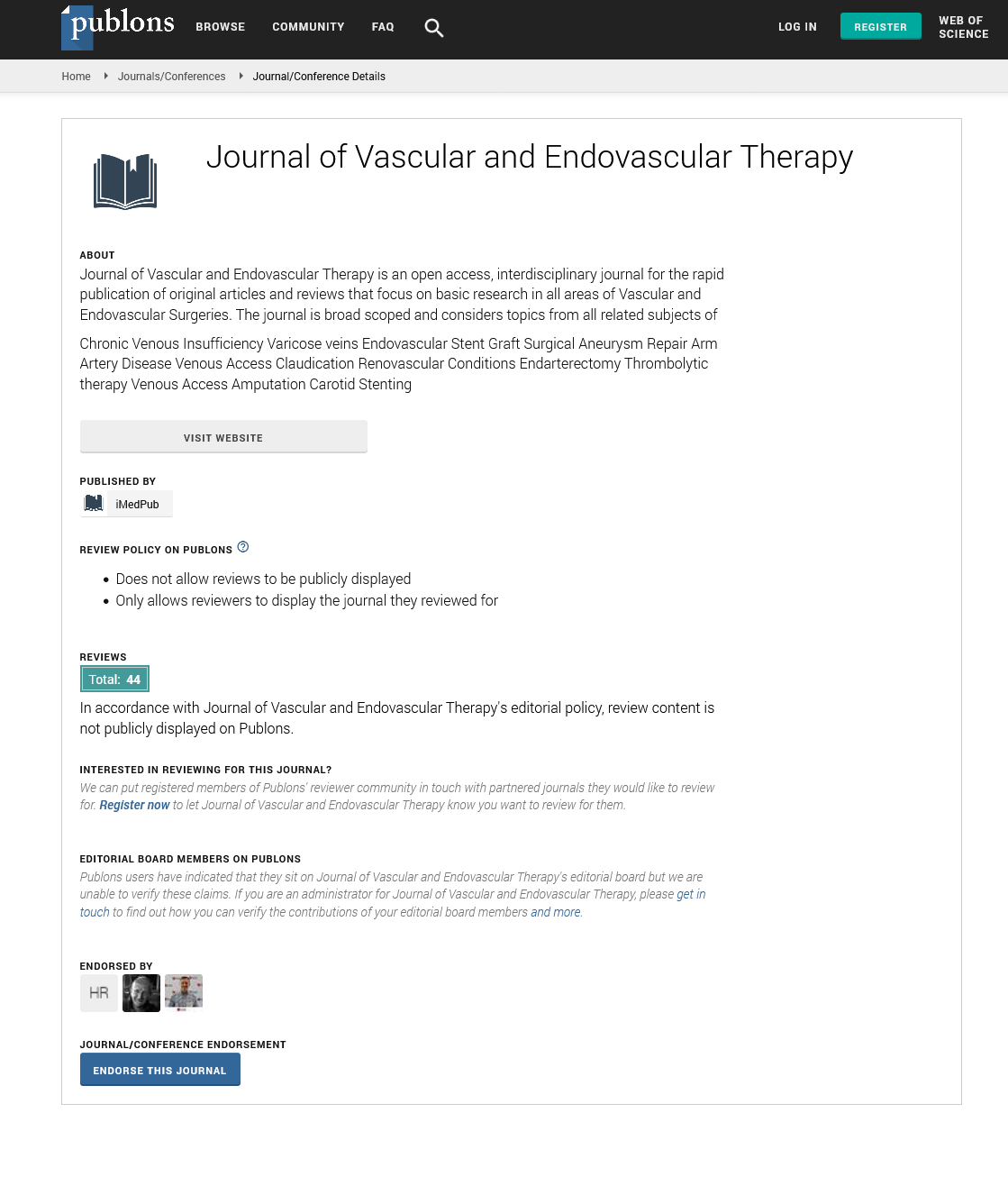ISSN : 2634-7156
Journal of Vascular and Endovascular Therapy
Histone citrullination of neutrophil extracellular traps is a novel biomarker and target to inhibit progression of abdominal aortic aneurysms
3rd Edition of World Congress & Exhibition on Vascular Surgery
May 24-25, 2018 London, UK
Wolf Eilenberg, Christoph Neumayer, Branislav Zagrapan, Luca Martelanz, Marie-Therese Grasl, Alexandros Potolidis, Paimann Nawrozi, Patrick Kirchweger, Christoph Domenig, Ihor Huk and Christine Brostjan
Medical University of Vienna, Austria
ScientificTracks Abstracts: J Vasc Endovasc Therapy
DOI: 10.21767/2573-4482-C1-002
Abstract
Neutrophil extracellular traps (NETs) have been implicated in the pathogenesis of abdominal aortic aneurysms (AAAs). NET formation involves histone modifications such as citrullination allowing for DNA decondensation and DNA release into extracellular space. NETs have been detected in the adventitia and intraluminal thrombus (ILT) of AAAs and the associated proteins have been proposed to promote the inflammatory reaction that drives aneurysm development. Our study has addressed the notion that NET components might serve as AAA biomarkers or novel targets of AAA therapy. Parameters of neutrophil activation as well as NET formation were determined in blood and tissue samples collected from 40 AAA patients (scheduled for surgical repair) and 40 healthy controls matched for age, sex, body mass index and smoking habit. Neutrophil and NET components were determined by ELISA in patient plasma or conditioned medium of resected tissue. NETs were visualised in aortic wall and ILT by immunofluorescence microscopy. In a model of AAA formation based on angiotensin II administration to ApoE null mice, inhibition of NET formation was tested by applying a citrullination blocker. Among the tested parameters of neutrophil activation and NET formation, citrullinated histone H3 was found to be significantly increased in blood (median 362 vs. 309 ng/ml p=0.004) and aortic tissue (50.9 vs. 3.7 ng/mg p=0.001) of AAA patients compared to healthy controls. Furthermore, NETs were highly prevalent in the intraluminal thrombus (corresponding to 642.3 ng citrullinated histone H3 per mg ILT). Plasma levels of citrullinated histone H3 decreased significantly after surgical repair. In vivo application of a citrullination inhibitor significantly reduced the capacity of mouse neutrophils to undergo NET formation. Furthermore, when aneurysm formation was initiated by angiotensin II application, disease progression was prevented in mice treated with the NET inhibitor (N=5) as compared to controls (N=5; p=0.014). Histone citrullination which occurs during the
formation of neutrophil extracellular traps was revealed as a biomarker of AAA formation and a potential therapeutic target to control aneurysm progression in established disease (as would be required for clinical application). Recent Publications 1. Eilenberg W, Stojkovic S, Piechota-Polanczyk A, Kaun C, Rauscher S, Groger M, et al. Neutrophil GelatinaseAssociated Lipocalin (NGAL) is Associated with Symptomatic Carotid Atherosclerosis and Drives Proinflammatory State In Vitro. Eur J Vasc Endovasc Surg. 2016 May;51(5):623-31. PubMed PMID: 26947538. Epub 2016/03/08. 2. Eilenberg W, Stojkovic S, Kaider A, Kozakowski N, Domenig CM, Burghuber C, et al. NGAL and MMP-9/ NGAL as biomarkers of plaque vulnerability and targets of statins in patients with carotid atherosclerosis. Clin Chem Lab Med. 2017 Jun 26. PubMed PMID: 28672747. Epub 2017/07/05. eng. 3. W. Eilenberg, S. Stojkovic, A. Piechota-Polanczyk, A. Kaider, N. Kozakowski, W. Weninger, J. Nanobachvili, J. Wojta, I. Huk, S. Demyanets, C. Neumayer Neutrophil Gelatinase Associated Lipocalin (NGAL) is elevated in type 2 diabetics with carotid artery stenosis and reduced under metformin treatment Cardiovascular Diabetology (2017) 8;16 (1):98
Biography
Wolf Eilenberg is a surgeon at the Department of Surgery at the Medical University Vienna. His research focus and expertise involves the role of neutrophils in carotid atherosclerotic disease and biomarkers of vulnerable carotid plaque. During the last few years, his primary interest was NGAL (Neutrophil gelatinase associated lipocalin), where he was able to show, that NGAL may identify the vulnerable plaque by a simple ELISA test in peripheral blood. For this work he was awarded the Finlandia prize 2016. Recently his field of interest widened towards the role of neutrophils in abdominal aortic aneurysm. Neutrophils, which were citrullinated may expulse their inside
DNA, forming neutrophil extracellular traps (=NETs), which are associated with significant inflammatory processes in the abdominal aortic wall and intraluminal thrombus. He extended his experience by murine AAA models investigating possible treatment options in AAA by applying NET-inhibitors
Email:wolf.eilenberg@meduniwien.ac.at
Google Scholar citation report
Citations : 177
Journal of Vascular and Endovascular Therapy received 177 citations as per Google Scholar report
Journal of Vascular and Endovascular Therapy peer review process verified at publons
Abstracted/Indexed in
- Google Scholar
- Open J Gate
- Publons
- Geneva Foundation for Medical Education and Research
- Secret Search Engine Labs
Open Access Journals
- Aquaculture & Veterinary Science
- Chemistry & Chemical Sciences
- Clinical Sciences
- Engineering
- General Science
- Genetics & Molecular Biology
- Health Care & Nursing
- Immunology & Microbiology
- Materials Science
- Mathematics & Physics
- Medical Sciences
- Neurology & Psychiatry
- Oncology & Cancer Science
- Pharmaceutical Sciences
